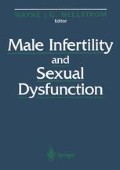Abstract
Erectile dysfunction may be caused by psychological problems, neurogenic dysfunction, hormonal alterations, or compromised penile blood flow. Better understanding of the erectile mechanism and the development of new investigative techniques have led to dramatic improvements in researchers’ ability to recognize the etiology of impotence. Clinical investigations suggest that the majority of patients experiencing erectile impotence are impotent because of vascular abnormalities.
Access this chapter
Tax calculation will be finalised at checkout
Purchases are for personal use only
Preview
Unable to display preview. Download preview PDF.
References
Lue T, Tanagho E. Physiology of erection and pharmacological management of impotence. J Urol 1987; 137: 829–836.
Wespes E, Depierreux M, Schulman CC. Use of biopty gun for corpus cavernosum biopsies. Eur Urol 1990; 18: 81–83.
Wespes E, Goes PM, Schiffmann S, et al. Computerized analysis of smooth muscle fibers in potent and impotent patients. J Urol 1991; 146: 1015–1017.
Wespes E, Moreira de Goes P, Schulman CC. Vascular impotence: focal or diffuse penile disease. J Urol 1992; 149: 1435–1436.
Wespes E, Moreira de Goes P, Sattar AA, et al. Objective criteria in the long-term evaluation of penile venous surgery. J Urol 1994; 152: 889–890.
Andersson K-E, Holmquist F. Mechanisms for contraction and relaxation of human penile smooth muscle. Int J Impotence Res 1990; 2: 209–225.
Giuliano FA, Rampin O, Benoit G, et al. Neural control of penile erection. In: Melman A, ed. The Urologic Clinics of North America. Philadelphia: W.B. Saunders; 1995; 22: 747–766.
Wespes E, Schulman CC. Venous impotence: pathophysiology, diagnosis and treatment. Urol 1993; 149: 1238–1245.
Wagner G, Gerstenberg T, Levin RJ. Electrical activity of corpus cavernosum during flaccidity and erection of the human penis: a new diagnostic method? Urol 1989; 142: 723–725.
Christ GJ, Maayani S, Valcic M, et al. Pharmacological studies of human erectile tissue: characteristics of spontaneous contractions and alterations in a-adrenoceptor responsiveness with age and disease in isolated tissues. Br J Pharmacol 1990; 101: 375–381.
Christ GJ, Brink PR, Melman A, et al. The role of gap junctions and ion channels in the modulation of electrical and chemical signals in human corpus cavernosum smooth muscle. Int J Impotence 1993; 5: 77–96.
Stief CG, Benard F, Bosch RJLH, et al. Acetylcholine as a possible neurotransmitter in penile erection. J Urol 1989; 14: 1444–1448.
Hedlund H, Andersson K-E. Comparison of the responses to drugs acting on adrenoceptors and muscarinic receptors in human isolated corpus cavernosum and cavernous artery. J Auton Pharmacol 1985; 5: 81–88.
Burnett AL, Tillman SL, Chana TSK, et al. Im-munohistochemical localization of nitric oxide synthase in the autonomic innervation of the human penis. J Urol 1993; 150: 73–76.
Furchgott RF, Zawadzki JV. The obligatory role of endothelial cells in the relaxation of arterial smooth muscle by acetylcholine. Nature 1980; 288: 373–376.
Kim N, Azadzoi KM, Goldstein I, et al. A nitric oxide-like factor mediates nonadrenergic-noncholinergic neurogenic relaxation of penile corpus cavernosum smooth muscle. J Clin Invest 1991; 88: 112–118.
Rajfer J, Aronson WJ, Bush PA, et al. Nitric oxide as a mediator of relaxation of the corpus cavernosum on response to nonadrenergic, noncholinergic neurotransmission. N Engl J Med 1992; 326: 90–94.
Trigo-Rocha F, Aronson WJ, Hohenfellner M, et al. Nitric oxide and cGMP: mediators of pelvic nerve-stimulated erection in dogs. Am J Physiol 1993; 264: H419–422.
Hedlund H, Andersson K-E. Effects of some peptides on isolated human penile erectile tissue and cavernous artery. Acta Physiol Scand 1985; 124: 413–419.
Adaikan PG, Kottegoda SR, Ratnani SS. Is vasoactive intestinal polypeptide the principal transmitter involved in human penile erection? J Urol 1986; 135: 638–640.
Gu J, Polak JM, Lazarides M, et al. Decrease of vasoactive intestinal polypeptide (VIP) in the penises from impotent men. Lancet 1994; 11: 315–318.
Steers WD, McDonnell J, Benson GS. Anatomical localization and some pharmacological effects of vasoactive intestinal polypeptide in human and monkey corpus cavernosum. J Urol 1984; 132: 1048–1093.
Sundler F. Relaxation of isolated human corpus spongiosum induced by vasoactive intestinal polypeptide, substance P, carbachol and electrical field stimulation. World J Urol 1983; 1: 203–208.
Virag R, Ottesen B, Fahrenkrug J, et al. Vasoactive intestinal polypeptide release during penile erection in man. Lancet 1982; 2: 11–66.
Saenz, de Tejada I, Goldstein I, Azadzoi K et al. Role of endothelin, a novel vasoconstrictor peptide in the local control of penile smooth muscle. J Urol 1989; 141: 222A.
Wespes E, Schiffman S, Gilloteaux J, et al. Study of neuropeptide Y-containing nerve fibers in the human penis. Cell Tissue Res 1988; 254: 69–74.
Editor information
Editors and Affiliations
Rights and permissions
Copyright information
© 1997 Springer Science+Business Media New York
About this chapter
Cite this chapter
Wespes, E. (1997). The Role of the Cavernosal Biopsy and Studies on Penile Innervation. In: Hellstrom, W.J.G. (eds) Male Infertility and Sexual Dysfunction. Springer, New York, NY. https://doi.org/10.1007/978-1-4612-1848-7_28
Download citation
DOI: https://doi.org/10.1007/978-1-4612-1848-7_28
Publisher Name: Springer, New York, NY
Print ISBN: 978-1-4612-7310-3
Online ISBN: 978-1-4612-1848-7
eBook Packages: Springer Book Archive

